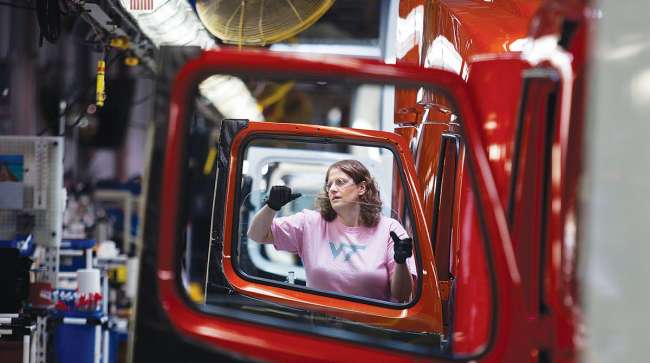Senior Reporter
Class 8 Orders in July Reach All-Time High of 52,400

Class 8 orders in July set an all-time monthly high, soaring past 52,000 and breaking a 12-year-old mark amid a crush of demand.
Orders hit 52,400, ACT Research Co. reported, citing a preliminary figure it will adjust when final data is out.
The previous record of 52,194 was set in March 2006, according to ACT.
“July’s activity was nearly triple that of July 2017 [when orders were 18,726],” said ACT Vice President Steve Tam. “The feat is made even more spectacular since July is typically the weakest order intake month of the year.”

Tam
At least one truck maker has already opened up its data books for model year 2020 equipment, which will be built after the first of the year in 2019, he said.
“And shazam, it won’t be long before others follow suit,” he added.
That typically doesn’t happen until early fall, he said. “It’s just indicative of how tight capacity is. In this calendar year, it may turn out that July is the strongest month.”
Orders through the first seven months have totaled nearly 301,000, as tallied by ACT.
One investment analyst reviewing the July numbers saw signs of truck dealers stocking up.
“The [truck makers] are opening up their production schedules for next year and the strength in orders is coming from dealers as they are preparing for a strong 2019, and have been frozen out of build schedules for this year — over 90% of the orders in June were for 2019,” Credit Suisse analyst Jamie Cook wrote in an investor note.
Carriers are posting record profit margins as the broader environment for the trucking industry remains very strong, Cook said.
The current economic expansion has been underway for nine years as of July. If it lasts another year, it would be the longest on record, according to experts.
One multi-location truck dealer said forecasts of a record-setting truck market in 2018 followed by another in 2019 is prompting action now.
“Dealers with enough wherewithal to support large inventories are indeed driving build and order demands,” and these are coming as truckers are “finally getting their due share in rate increases,” said David Kriete, CEO of the Wisconsin-based Kriete Group.
In July, ACT forecast production levels in 2019 could reach the third-highest level ever, and it expects 2018 to be the fifth-highest level ever, if current demand stays on track.
“Even in the absence of confirmed customer orders, dealers need to heavily rely on speculative orders because inevitably all truck makers will reach their production capacity,” said Kriete — whose dealerships represent Mack Trucks, Volvo Trucks North America, Hino and Mitsubishi-Fuso. Mack and VTNA are Volvo Group brands.
The research firm FTR pegged orders at 52,250.

Ake
The current shortage of trucks is unique, said Don Ake, FTR vice president for commercial vehicles.
“In normal shortage situations, supply and demand get brought back into balance because prices increase, slowing demand and speeding supply. In trucking equipment, the prices were quoted and locked into months ago and can’t be increased. New quotes can, and it will be interesting to see how this plays out next year,” Ake said.
“Also, dealers may be able to raise prices to smaller customers. But higher prices can’t fix the imbalance right now, only greater supply [will],” he said.
One truckload carrier has added trucks to supply more dedicated contract carriage.
Werner Enterprises Inc. has added 565 trucks over the year to its dedicated fleet, and is increasing its capital expenditures on fixed assets, including new trucks, even as the average age of its fleet is 1.9 years.
“Changing industry dynamics are occurring as customers shift freight from one-way fleets to shorter length of haul dedicated fleets, which result in the need for more trucks to haul the same amount of freight,” according to the company’s latest quarterly earnings release.
Werner ranks No. 15 on the Transport Topics Top 100 list of the largest for-hire carriers in North America.
Werner reported capital expenditures in the first half of 2018 were $174.8 million compared with $66 million a year earlier, and will be in the range of $325 million to $375 million for the full year as it takes advantage of the Tax Cuts and Jobs Act of 2017 to increase its tractor (and trailer) fleet — reflecting its higher confidence in potential growth due to a strong dedicated pipeline and overall market demand.
At the same time, another industry observer was skeptical that all these orders would turn into trucks bound for fleet operations.
“Very rarely does this magnitude of orders completely make its way to retail sales, with higher cancellation rates typical at some later date. Using the last mini-cycle as a reference, surprising strong orders in late 2014 were, in retrospect, attributable to dealer incentivizing at the [European-based truckmakers]. Higher cancellation rates, started to show up 9 to 12 months later,” David Leiker, an analyst with R.W. Baird & Co., wrote to investors.




